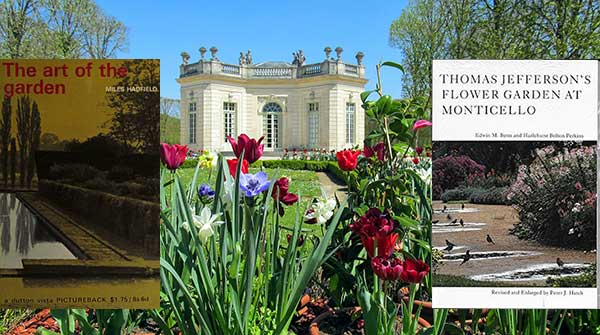Two books from the past take us on a worldwide adventure of gardening
 Ah, fall. It’s been a month of unseasonably warm temperatures in southern Ontario, but that’s beginning to change. The air is becoming more crisp with each passing day. The leaves turned into the usual assortment of vibrant colours, but are starting to become the permanent property of rakes and leaf blowers.
Ah, fall. It’s been a month of unseasonably warm temperatures in southern Ontario, but that’s beginning to change. The air is becoming more crisp with each passing day. The leaves turned into the usual assortment of vibrant colours, but are starting to become the permanent property of rakes and leaf blowers.
Halloween decorations are resting upon many a lawn, too. Children are gearing up to go out trick-or-treating tonight. This includes my son, the pirate!
As we inch closer to another months-long battle with Ol’ Man Winter, let’s focus on something else we’ll soon be leaving behind: gardening.
The history and art of the garden isn’t one of my specific areas of interest. Nevertheless, there are insights we can learn from this fascinating pastime and, in certain instances, vocation. This includes the botanical interests, observations and green thumb of a former U.S. president.
 |
Miles Hadfield’s The Art of the Garden (1965) is a fine introduction to the brilliant gardens found in Europe, Asia and the United States. The author, who served as the Garden History Society’s first president, was one of the foremost writers and illustrators of British gardening. He also worked with the National Trust to help revitalize historic gardens that had fallen on hard times and disrepair, including Westbury Court Garden in Gloucestershire.
Two types of gardens are identified in Hadfield’s book. “Sometimes they are for his own private enjoyment,” he wrote, which served as “secret places in which to hide from the world and its follies.” One such place was British poet William Shenstone’s garden at The Leasowes, which was visited by future U.S. presidents John Adams and Thomas Jefferson. (More on the latter shortly.) The garden can also “form the permanent scenery for aggrandizement, parade and display.” This includes the Hanging Gardens of Babylon, an ancient wonder that may or may not have existed, and King Louis XIV’s magnificent horticultural display at Versailles, France.
Each country has developed its own unique style of designing and constructing a garden.
Hadfield noted that France’s gardens were “centred on the Court rather than, as in Italy, distributed among the popes, cardinals and nobility.” French families passed down these traditions through several generations. There was also a royal connection to the garden, as exemplified by Catherine de Medici. She was born in Florence, Italy and married King Henry II of France. Upon his death, she developed the Tuileries and “established a sort of central school of gardening which evolved a tradition of training not only in horticulture in its widest aspects, but in the architecture of garden design.” The author also noted the French “were masters of hydraulics” who built elaborate fountains that served as the centrepiece of many exquisite gardens along the countryside.
Meanwhile, Germany’s Schloss Benrath has a garden that, “on account of spacious avenues and fine trees combined with classical statuary,” has been “compared to an old English formal garden.” The Dutch transformed from a gardening style that was “more confined, more covered with frivolous ornaments” to an emphasis on horticulture and being “among the first introducers of foreign plants – especially bulbs.” Italy’s Isola Bella has a 17th-century baroque masterpiece of architecture and horticulture that’s “regarded as one of the greatest gardens in the world.”
There’s also an array of magnificent British gardens in locations like Sheffield Park, the Persian gardens at India’s Taj Mahal, Chinese and Japanese gardening techniques that flow with nature, and the “calm classicism” of some older American gardens.
Which brings us back to Jefferson.
Edwin M. Betts and Hazlehurst Bolton Perkins’s Thomas Jefferson’s Flower Garden At Monticello (1971) examines the third U.S. president’s lifelong interest in horticulture. It began while growing up in Shadwell, Virginia. He kept a garden book that referred to the plants he grew and rough diagrams of where everything was situated. He also had books in his personal library on agriculture, botany and gardening styles and techniques.
By the time Jefferson had moved to Monticello in Nov. 1770, “he was not only an experienced gardener but one who had observed gardens and gardening in many places.”
Jefferson repeatedly devised lavish plans for remodelling his house and garden. He knew that weather “was of the first importance,” according to Betts and Perkins, since the estate was situated on a Virginia mountaintop. He built cisterns and made “elaborate plans for building ponds in various places near the house for the conservation of rainwater.” (He only ended up constructing a small number of them.) He focused on planting flowers like tulips and hyacinths. He had a surprisingly small greenhouse, which led the authors to suggest that “it is doubtful whether Jefferson ever grew many plants” in it.
While Jefferson had many “happy moments” in Monticello, he left them “for the drudgery of Washington official life.” Betts and Perkins noted that “his mind was still on his gardens.” They would always remain there until he passed away on July 4, 1826 – the same day as Adams, his longtime friend and political rival.
It’s a sentiment many Canadians would share. The winter months in the Great White North are enjoyable, but the happy moments puttering around in our gardens can’t return soon enough.
Michael Taube, a Troy Media syndicated columnist and Washington Times contributor, was a speechwriter for former Prime Minister Stephen Harper. He holds a master’s degree in comparative politics from the London School of Economics.
For interview requests, click here.
The opinions expressed by our columnists and contributors are theirs alone and do not inherently or expressly reflect the views of our publication.
© Troy Media
Troy Media is an editorial content provider to media outlets and its own hosted community news outlets across Canada.

